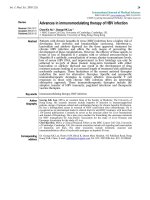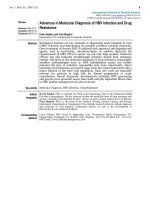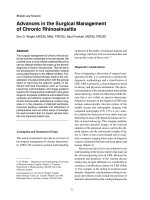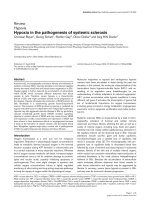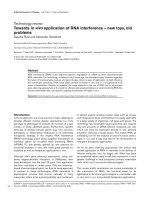Báo cáo y học: "Advances in immunomodulating therapy of HBV infection"
Bạn đang xem bản rút gọn của tài liệu. Xem và tải ngay bản đầy đủ của tài liệu tại đây (222.38 KB, 6 trang )
Int. J. Med. Sci. 2005 2(1)
24
International Journal of Medical Sciences
ISSN 1449-1907 www.medsci.org 2005 2(1):24-29
©2005 Ivyspring International Publisher. All rights reserved
Advances in immunomodulating therapy of HBV infection
Review
Received: 2004.10.01
Accepted: 2005.01.01
Published:2005.01.05
Chee-Kin Hui
1
, George KK Lau
2
1. MRC Cancer Cell Unit, University of Cambridge, Cambridge, UK.
2. Department of Medicine, University of Hong Kong, Hong Kong
A
A
b
b
s
s
t
t
r
r
a
a
c
c
t
t
Patients with chronic hepatitis B virus (HBV) infection have a higher risk of
developing liver cirrhosis and hepatocellular carcinoma. Interferon-α,
lamivudine and adefovir dipivoxil are the three approved treatment for
chronic HBV infection and offers the only means of preventing the
development of these complications. However, the efficacy of these agents, in
terms of loss of Hepatitis B e antigen with or without seroconversion to
Hepatitis B e antibody, normalization of serum alanine transaminase levels,
loss of serum HBV DNA, and improvement in liver histology can only be
achieved in 20-30% of those treated. Long-term treatment with either
lamivudine or adefovir dipivoxil can result in the development of drug
resistant mutants leading to an increased length of treatment with additional
nucleoside analogues. These limitations of the current antiviral therapies
underline the need for alternative therapies. Specific and nonspecific
immunotherapeutic strategies to restore effective virus-specific T cell
responses in those with chronic HBV infection offers an interesting
alternative approach. These immunotherapeutic therapies include the
adoptive transfer of HBV immunity, pegylated interferon and therapeutic
vaccine therapies.
K
K
e
e
y
y
w
w
o
o
r
r
d
d
s
s
immunomodulating therapy, HBV infection
A
A
u
u
t
t
h
h
o
o
r
r
b
b
i
i
o
o
g
g
r
r
a
a
p
p
h
h
y
y
George KK Lau, MD is an Assistant Dean of the Faculty of Medicine, The University of
Hong Kong. His research interests include hepatitis B infection in immunosuppressed
patients, design of immune-related and combination therapy for chronic hepatitis B infection.
He has a distinguished career in research of HBV reactivation after chemotherapy. He is
recognized as an international leader in clinical trials for anti-HBV treatment, with more than
150 journal publications. Currently he serves as the associate editor for Liver International
and Journal of Hepatology. He is also a key member for formulating the consensus statement
for HBV management for Asia-Pacific Association for the study of Liver Diseases and
European Association for the study of Liver.
Chee-Kin Hui, MD is a Clinical Research Fellow at the MRC Cancer Cell Unit, University
of Cambridge, Cambridge, UK. His current researches include cell signaling and transcription
of hepatoma cell lines. His other researches include treatment, outcome and
immunomodulatory effect of nucleoside analogues on hepatitis B virus.
C
C
o
o
r
r
r
r
e
e
s
s
p
p
o
o
n
n
d
d
i
i
n
n
g
g
a
a
d
d
d
d
r
r
e
e
s
s
s
s
Dr. George KK Lau. Room 1838, Block K, Queen Mary Hospital, 102 Pokfulam Road, Hong
Kong SAR, China. E-mail. Tel: 852- 28553986 Fax: 852- 28190694
Int. J. Med. Sci. 2005 2(1)
25
1. INTRODUCTION
Hepatitis B virus (HBV) related hepatitis is a necroinflammatory liver disease of variable severity. Most people develop acute
hepatitis which is controlled by both humoral and cellular immune responses following acute infection [1]. However, around 2-20%
of infected adults and 95% of infected newborns in HBV-endemic areas fail to resolve the infection and subsequently become
chronic carriers [2]. Persistent infection is associated with a healthy chronic carrier state in about one-third of persons and with
chronic liver disease that can lead to the development of liver cirrhosis and hepatocellular carcinoma in the remaining two-thirds.
The cellular immune response contributes to the elimination of the virus but is also responsible for liver damage caused by the
lytic activity of HBV-specific cytotoxic T lymphocytes (CTL) on HBV-infected hepatocytes and by production of inflammatory
cytokines [3]. Chronic HBV infection is characterized by an inefficient T helper (Th) cell response to hepatitis B surface antigen
(HBsAg) and by a variable Th cell response to the HBV-related antigens such as hepatitis core antigen (HBcAg), and hepatitis e
antigen (HBeAg). Increased HBcAg/HBeAg-specific Th cell responses are observed in persons with self-limited HBV-infection,
whereas the HBsAg-specific Th cell response is much less vigorous [1]. However, in a proportion of vaccine recipients who have
been immunized with plasma-derived or recombinant HBsAg, there is a strong response of the envelope-specific Th response
suggesting that differences in antigen load or presentation may influence the strength of the HBsAg-specific T cell response [4-6].
Therapeutic intervention offers the only means of interrupting this progression. The ultimate goals of treatment are to achieve
off-treatment sustained suppression of HBV replication and remission of liver disease. Agents currently approved for treatment of
chronic HBV infection are divided into two main groups; the immunomodulator, interferon-α (IFN-α), and the nucleoside
analogues, lamivudine and adefovir dipivoxil. The immunomodulators act by promoting cytotoxic T cell activity for lysis of
infected hepatocytes and by stimulating cytokine production for control of viral replication. Nucleoside analogues on the other hand
act by suppressing HBV replication at the level of DNA synthesis, and may also enhance immune clearance of infected hepatocytes
[7]. As IFN-α inhibit HBV replication in only 20-40% of persons with chronic HBV [8-10], while the use of nucleoside/nucleotide
analogues such as lamivudine and adefovir dipivoxil is limited by the selection of resistant mutated viruses [11,12], there is a need
for alternative approaches to treatment which includes specific and non-specific immunotherapeutic strategies in order to enhance or
to broaden the defective T cell responses in chronically infected patients. These immunotherapeutic strategies are the adoptive
immune transfer, new forms of immunomodulatory agents and therapeutic vaccine therapies.
2. ADOPTIVE TRANSFER OF IMMUNITY
In both animal and human studies, transfer of HBV immune memory from a immune donor through bone marrow
transplantation (BMT) or peripheral blood lymphocytes (PBLs) has enabled seroconversion to Hepatitis B surface antibody in HBV
naïve recipients [13-16]. Furthermore, clearance of HBsAg has been observed in individual patients with chronic hepatitis B after
transplantation of bone marrow from HBV immune donors [17-19]. By studying the largest series of patients, who cleared HBsAg
following the engraftment of an HLA-identical bone marrow from a donor with past exposure to HBV, we found that resolution of
chronic HBV infection is associated with a transfer of CD4+ T lymphocyte reactivity to HBcAg, rather than to HBV envelope
proteins [20]. We have demonstrated that the CD4+ T cells are of donor origin and activation of the memory subset, CD45-RO+ T
cells, occurs during the hepatitis flare, which precedes the seroconversion to anti-HBs. These results explain our earlier clinical
observation that HBsAg clearance occurs only after adoptive transfer of naturally acquired immunity to HBV (anti-HBs and anti-
HBc positive donors) and not in patients who received marrow with a vaccine-induced immunity (anti-HBs alone) [21].
The
practical implication of the present findings of successful HBsAg clearance following adoptive transfer of immunity to HBcAg, is
that therapeutic immunization of patients with chronic HBV infection should include the HBV nucleocapsid protein (or the core
gene for DNA immunization) and aim to induce both HBcAg-specific CD4+ and CD8+ T cell responses.
However, although adoptive transfer is an interesting alternative for the treatment of chronic HBV infection, it is associated
with certain risks. The risks of adoptive transfer are those associated with BMT and the absence of immune control that may result
in infections, veno-occlusive disease and graft-versus-host disease. Fulminant hepatitis resulting in hepatic failure has also been
reported following adoptive transfer of immunity to HBV [22]. Thus, although adoptive transfer of immunity to HBV is a possible
approach, it is restricted to the BMT setting and is limited by its potential serious complications.
Adoptive transfer of immunity to HBV has also been reported in patients after liver transplantation [23]. Spontaneous
production of anti-HBs is observed in 21 of 50 HBsAg+ patients (42%) receiving lamivudine monoprophylaxis after liver
transplantation. Seroconversion to anti-HBs can be detected in a median of eight days. In those that developed anti-HBs
seroconversion, a more rapid clearance of HBsAg is also observed and the predictor of anti-HBs production is an HBV-immune
donor, suggesting the possibility of adoptive immunity transfer through a liver graft. The same could be observed in rats after kidney
transplantation [24].
3. IMMUNOMODULATORY TREATMENTS OF CHRONIC HEPATITIS B INFECTION
Cytokines
Interferon-gamma, tumour necrosis factor-alpha and interleukin 1-beta has been shown to decrease the secretion of HBV DNA
from HB611 cells transfected with HBV DNA in a dose dependent manner [25]. The expression of HBV mRNA is also decreased
signifying that these agents can decrease the synthesis of virally encoded components of the HBV virions. The antiviral effect of
these agents is postulated to be due to oxidative stress [25].
Interleukin 2 (IL-2)
Clearance of HBsAg with anti-HBs seroconversion has been demonstrated in co-infected patients with human
immunodeficiency virus (HIV) [26]. However, similar results could not be reproduced when IL-2 is extended to chronic HBV
patients without HIV co-infection. [27]. Further randomized trials with IL-2 versus placebo also did not demonstrate any difference
between IL-2 and placebo [28,29]. A randomized trial of combination IL-2 and IFN-α2b versus IFN-α2b monotherapy in 37
Int. J. Med. Sci. 2005 2(1)
26
patients also did not show any effect on serum HBV DNA clearance, HBeAg seroconversion or normalization of serum alanine
transaminase (ALT) levels. However, side effects are higher in the combination group [30]. Therefore, there is no strong evidence to
demonstrate the effect of IL-2 on chronic HBV infection.
Interleukin-12 (IL-12)
IL-12 is a heterodimeric cytokine produced by antigen-presenting cells that have the ability to induce interferon-γ (IFN-γ)
secretion by T and natural killer cells and it can generate normal Th1 responses. As HBV-specific CTL can inhibit HBV replication
in the livers of transgenic mice mediated by IFN-γ, there could be a possible therapeutic effect of IL-12 on HBV replication.
A study demonstrating this on HBV transgenic mice is conducted by Cavanaugh et al [31]. The authors are able to demonstrate
a dose-dependent antiviral effect with the disappearance of HBV DNA replicative intermediates with IL-12 at doses of 100 ng once
a day for three days. At further higher doses, HBV DNA replicative forms were completely abolished. Serum HBV DNA level is
also decreased by IL-12 [31].
In another study with recombinant human (rHu) IL-12 on 46 patients with chronic HBV, positive serum HBV DNA level and
elevated serum ALT level, a decrease in serum HBV DNA level could be observed at the end of treatment and at 12 weeks after the
end of treatment. The decrease in serum HBV DNA level is also dose dependent; 25% with 0.50 µg/kg body weight (b.w.), 13%
with 0.25 µg/kg b.w. and 7% 0.03 µg/kg b.w. HBeAg is undetectable in two patients (13.3%) in those who received 0.25 µg/kg b.w.
and in three patients (18.8%) receiving 0.50 µg/kg b.w [32]. Although IL-12 shows early interesting efficacy on chronic HBV
infection, more large randomized controlled studies are needed before it can be recommended as a standard treatment.
Levamisole
One study showing the immunomodulatory effect of levamisole in 25 chronic HBV patients (16 HBeAg+, 9 HBeAg-) is
conducted by Krastev et al. in 1999. A decrease in serum HBV DNA level is noted (p<0.05) with HBeAg seroconversion to
Hepatitis B e antibody in three (18.8%) HBeAg positive patients. Two patients (8.0%) in this study cleared HBsAg [33].
Oral Immune Regulation (HBV Envelope Proteins)
Oral immune regulation is the induction of immunological hypo- or hyper responsiveness toward specific antigens or, towards
other antigens present at the target site [34]. Per oral administration of low doses of HBsAg+preS1+preS2 envelope proteins can
induce peripheral immune tolerance and downregulation of anti-HBV immune response has been demonstrated in a murine model
[35]. Safadi et al. conducted a study on the safety and efficacy of per oral HBV envelope proteins (HBsAg+preS1+preS2) in 42
chronic HBV patients [36]. A significant decrease in serum HBV DNA level can be observed in 66.6% while histological
improvement in liver necroinflammatory score can be seen in 30.0%. Loss of HBeAg occurred in 26.3% and 21.1% had HBeAg to
anti-HBe seroconversion. No patients had a lost of HBsAg or anti-HBs seroconversion.
Thymosin α-1
Thymosin α-1 is a 28-amino acid polypeptide isolated from thymosin fraction 5. It is an immunomodulating agent and may
enhance clearance of HBV. In vitro studies have shown that thymosin α-1 can accelerate T-cell maturation and antigen recognition.
It can also stimulate interferon and cytokine production and the activity of natural killer cell-mediated cytotoxicity [37,38].
Although thymosin α-1 has fewer and milder side effects compared to IFN-α, its clinical efficacy remains inconclusive. One
study with 1.6 mg twice weekly subcutaneous thymosin α-1 for six months showed a response rate, defined as clearance of serum
HBV DNA and HBeAg, of 40.6% vs. 9.4% in the control group (p=0.004) 18 months after the completion of treatment, although the
response rate between the two groups are similar at the end of treatment [39]. In a meta-analysis of 353 patients from five trials,
there is no statistically significant difference in the biochemical response although odds ratio for virological response at the end of
treatment, six and 12 months after treatment are 0.56 (0.20-1.52), 1.67 (0.83-3.37) and 2.67 (1.25-5.68) respectively. Interestingly,
an increase in virological response over time after the discontinuation of thymosin could be observed (p=0.02) [40]. The doses of
thymosin α-1 in this meta-analysis are 900 µg/m
2
and 1.6 mg twice weekly respectively for at least 24 weeks.
Combination of low dose lymphoblastoid interferon and thymosin α-1 is evaluated in 15 patients. After 12 months, nine
patients (60.0%) responded to treatment, which is defined as negative serum HBV DNA level and normalization of serum ALT
level. Forty percent had clearance of HBsAg [41]. The efficacy of thymosin α-1 and IFN-α on HBeAg negative patients has also
been shown by Saruc et al. [42]. Fifty-two HBeAg negative chronic HBV patients are nonrandomly assigned to three different
groups. Group 1 (n=27) received thymosin α-1 1.6 mg subcutaneously twice a week and IFN-α2b 10 million units (MU)
subcutaneously three times weekly for 26 weeks followed by IFN-α2b for an additional 26 weeks. Group 2 (n=10) received IFN-
α2b monotherapy for 52 weeks and Group 3 (n=15) received IFN-α2b and lamivudine for 52 weeks followed by continuous
lamivudine. A sustained response, defined as virological and biochemical response six months after completion of therapy, is seen in
74.0% in Group 1, 40.0% in Group 2 and 26.6% in Group 3 (p=0.036). At the end of the study, which is 18 months after the
completion of treatment, 71.4% in Group 1, 10.0% in Group 2 and 20.0% in Group 3 had persistent sustained response (p=0.0003)
[42]. The results of the meta-analysis and, that of Chien et al. and Saruc et al. suggest that thymosin α-1 may be effective in
suppressing viral replication with its effect being delayed until 12 months after the discontinuation of treatment [40,42]
Furthermore, combination of thymosin α-1 and famciclovir for 26 weeks versus famciclovir monotherapy or placebo showed a
stronger HBV DNA reduction in the combination group with a 15.6% HBeAg seroconversion (none of the patients in the other two
groups had HBeAg seroconversion) [43].
Pegylated interferon alfa
Recently, pegylated interferons have been developed with improved pharmacokinetic profiles and a more acceptable dosing
regimen compared with conventional interferon (once-weekly subcutaneous injection). Clinical trials of pegylated interferons have
provided encouraging results. In an early, phase II, proof-of-concept trial, peginterferon alfa-2a (40KD) proved more effective than
conventional interferon alfa in all efficacy parameters assessed (loss of HBeAg, normalization of serum ALT) [44]. A later study of
266 predominantly Caucasian patients, showed that peginterferon alfa-2b (12KD) plus lamivudine combination therapy was no more
effective than peginterferon alfa-2b (12KD) alone [45]. Unfortunately, this study did not have a lamivudine monotherapy
Int. J. Med. Sci. 2005 2(1)
27
comparator arm. A new phase III study of 537 HBeAg negative, predominantly Asian patients, comparing peginterferon alfa-2a
(40KD), either alone or in combination with lamivudine for 72 weeks, showed a higher normalization of serum ALT levels and a
higher rate of reduction in serum HBV DNA level less than 10,000 copies/ml in the peginterferon alfa-2a (40 KD) groups (Table 1).
Loss of HBsAg with or without anti-HBs seroconversion and ≥ 2-point reduction in HAI index are also higher in patients receiving
peginterferon alfa-2a (40 KD) (Table 1) [46]. New data from a Phase III study of 814 predominantly Asian patients with
peginterferon alfa-2a (40KD), either alone or in combination with lamivudine, will be available soon.
Table 1. Results of phase III study with peginterferon alfa-2a (40 kDa) on HBeAg negative Chronic HBV patients.
ALT- alanine transaminase, HBV- hepatitis
B virus, HBsAg- hepatitis B surface
antigen, anti-HBs- antibody to hepatitis B
surface antigen, HBeAg- hepatitis B e
antigen.
Therapeutic Vaccine
This is another approach that can
be employed to break tolerance and
stimulate T-cell immune responses in
chronic HBV patients. Immunization
with recombinant HBsAg particles
from transgenic mice expressing either HBsAg alone or replicating the virus resulted in a reduction in serum HBsAg levels, loss of
HBeAg or even the development of anti-HBs [47,48]. Pilot clinical studies on therapeutic vaccines demonstrated that specific
vaccine therapy by standard vaccination could cancel or reduce HBV replication in 50.0% of chronic HBV patients [49,50]. In a
controlled study involving either GenHevac B (Pre-S2/S) [Pasteur-Merieux, n=47], Recombivax (S) [Merck, Sharp and Dhome,
n=34] or no vaccine (n=37), seroconversion of HBeAg to anti-HBe is seen in 13.3% of vaccinees versus 3.6% of controls after six
months of follow-up. After 12 months of follow-up, the HBeAg to anti-HBe seroconversion rate is 18.9% vs. 12.5% between the
two groups. None of the patients had a loss of HBsAg [51]. However, in a randomized controlled study by Yalcin et al. on 71
patients with GenHevac B (Pre-S2/S), this vaccine is not significantly associated with a higher HBsAg seroconversion. Only three
out of 31 patients (9.7%) who received the vaccine cleared HBsAg with anti-HBs seroconversion. While in the control group, none
of the 40 patients cleared HBsAg or developed anti-HBs seroconversion (p=0.079) [52].
Another study used adsorbed hepatitis B vaccine (MEINYU, Meiji Dairies Corporation, Tokyo) in 19 HBsAg patients with
detectable serum HBV DNA (vaccinated patients, n=13 and control, n=6). This vaccine contains glycosylated (gp26) and
nonglycosylated HBsAg spherical particles (23 nm in diameter) and 4.0% preS2 protein. At the end of the study there is a significant
decrease in the serum HBV DNA level in the vaccinated group compared to the control group (p=0.03). However, the proportion of
patients with HBsAg clearance and anti-HBs seroconversion is not available [53].
Alum-based vaccines can be used to promote the production of antibodies and a Th2 biased immune response. However, for
effective therapeutic vaccination, both humoral and cytotoxic T-cell responses would be required to eradicate infected liver cells. As
such, the efficacy of these vaccines can be improved by using adjuvants such as MF59 [54]. In a pilot study using MF59 as an
adjuvant, anti-HBs seroconversion is achieved in 11 of 13 patients [55]. CpG DNA, a synthetic oligonucleotide that can stimulate
Th1 responses, with production of IL-12 and IFN-γ is another such adjuvant [56]. Transgenic mice study with vaccines using CpG
DNA as an adjuvant has been shown to lead to clearance of serum HBsAg and anti-HBs seroconversion, with a downregulation of
HBV mRNA production in the liver as well [56].
Another approach with therapeutic vaccines is the use of peptide based T-cell vaccines. Heathcote et al. studied the use of a
lipopeptide (CY-1899) containing a T-helper epitope from tetanus toxoid and a CTL epitope from HBV core (amino acids 18-27) in
19 chronic HBV patients [57]. This CTL activity induced by the vaccine, however, is not strong enough to clear the infection. In
fact, CTL activity induced by vaccination with the highest dose are 10-fold weaker than the CTL responses induced in healthy
volunteers with no HBV exposure [58].
DNA-Based Vaccines
Intramuscular injection of plasmids encoding HBV antigens is another novel approach to vaccination. It can enable the
expression of encoded proteins in vivo. The DNA vaccines can induce immune responses against antigens synthesized in vivo after
direct introduction of DNA encoding HBV sequences. Plasmid DNA immunization can induce both humoral immune responses and
CD8+ CTL responses [59,60].
Immunization with HBsAg-encoding plasmid DNA, followed by recombinant HBsAg-expressing canarypox as booster in
chimpanzees with chronic HBV resulted in a 400-fold decrease in serum HBV DNA level with stable HBsAg levels [61]. Three
chimpanzees with chronic HBV immunized with a HBcAg-expressing retroviral vector showed seroconversion from HBeAg to anti-
HBe in one chimpanzee. The other two chimpanzees remained HBeAg positive with stable viral load, even though one of them had
detectable HBcAg-specific CTL responses [62].
A DNA vaccine against HBV using the PowderJect system has been conducted in healthy volunteers. This system delivers gold
particles coated with plasmid DNA directly into the skin cells. This vaccine seems to be safe, well tolerated and is able to produce
Th1 helper cell responses. But humoral anti-HBs responses, however, are weak [63].
Theoretically, the use of therapeutic vaccine may offer the greatest therapeutic potential. However, larger scale studies need to
be conducted in order to determine not only its efficacy but also its safety and potential adverse effects in humans. A more important
question that needs to be addressed is the potential adverse effects that may arise in the event of a hyper-responsiveness of the
cytotoxic activity in the HBV infected liver cells.
Peginterferon
alfa-2a (40 KD)
(n=177)
Peginterferon alfa-2a (40
KD) plus lamivudine
combination (n=179)
Lamivudine
(n=181)
Normalization of serum
ALT level
59% 60% 44%
Serum HBV DNA <10,000
copies/ml
43% 44% 29%
Loss of HBsAg ± anti-HBs
seroconversion
3.4% 0%
Reduction in HAI by ≥ 2
47% 37% 39%
Int. J. Med. Sci. 2005 2(1)
28
4. CONCLUSION AND RESEARCH DIRECTION
Monotherapy with nucleoside/nucleotide analogue is unlikely to cure the majority of patients with chronic hepatitis B infection.
With the encouraging results being obtained from the use of pegylated interferon α for chronic HBV infection, it is highly likely that
it will feature widely in future consensus guideline recommendations. However, it remains to be determined which patient should be
treated, for how long and whether combination therapy with other immunological therapy or nucleoside/nucleotide analogues will
further enhance its efficacy. A more rational form of therapy should entail the use of HBV-specific immune therapy either in the
form of therapeutic vaccine or DNA vaccine. Hopefully, in the future, more research could be conducted to find an immunological
curative solution for patients with chronic hepatitis B infection.
Conflict of interest
Dr. Lau has received research support from Roche Pharmaceutical and Gilead Sciences. Dr. Hui: none declared.
References
1. Chisari FV. Hepatitis B virus immunopathogenesis. Annu Rev Immunolo 1995; 13: 29-60.
2. Peters M, Vierling J, Gershwin ME, Milich D, Chisari FV, Hoofnagle JH. Immunology and the liver. Hepatology 1991; 13: 977-994.
3. Chisari FV. Immunobiology and pathogenesis of viral hepatitis. In: Rizetto M, Purcell RH, Gerin JL, Verme G, eds. Viral hepatitis and liver
disease. Turin, Italy: Edizioni Minerva Medica 1996; 405-414.
4. Celis E, Kung PC, Chang TW. Hepatitis-B related virus-reactive human T lymphocytes clones: antigen specificity and helper function for
antibody synthesis. J Immunol 1984; 132: 1511-1516.
5. Celis E, Ou D, Otvos L Jr. Recognition of hepatitis B surface antigen by human T lymphocytes. Proliferative and cytotoxic responses to a
major antigenic determinant defined by synthetic peptides. J Immunol 1988; 140: 1808-1815.
6. Ferrari C, Penna A, Bertoletti A, Cavalli A, Valli A, Schianchi C et al. The pre-S1 antigen of hepatitis B virus is highly immunogenic at the T
cell level in man. J Clin Invest 1989; 84: 1314-1319.
7. Boni C, Bertoletti A, Penna A, Cavalli A, Pilli M, Urbani S et al. Lamivudine treatment can restore T cell responsiveness in chronic hepatitis
B. J Clin Invest 1998; 102: 968-975.
8. Hoofnagle JH, di Bisceglie AM. The treatment of chronic viral hepatitis. N Eng J Med 1997; 336: 347-356.
9. Wong DKH, Cheung AM, O’Rourke K, Naylor CD, Detsky AS, Heathcote J. Effect of alpha-interferon in patients with hepatitis B e antigen-
positive chronic hepatitis B: a meta-analysis. Ann Intern Med 1993; 119: 312-323.
10. Niederau K, Heintges T, Lange S, Goldmann G, Niederau CM, Mohr L et al. Long-term follow-up of HBeAg-positive patients treated with
interferon-alpha for chronic hepatitis B. N Eng J Med 1996; 334: 1422-1427.
11. Lai CL, Chien RL, Leung NW, Chang TT, Guan R, Tai DI et al. One-year trial of lamivudine for chronic hepatitis B. Asia Hepatitis
Lamivudine Study Group. N Eng J Med 1998; 339: 61-68.
12. Angus P, Vaughan R, Xiong S, Yang H, Delaney W, Gibbs C et al. Resistance to adefovir dipivoxil therapy associated with the selection of a
novel mutation in the HBV polymerase. Gastroenterology 2003; 125: 292-297.
13. Ilan Y, Nagler A, Adler R, Naparstek E, Or R, Slavin S et al. Adoptive transfer of immunity to hepatitis B virus after T cell-depleted
allogeneic bone marrow transplantation. Hepatology 1993; 18: 246-252.
14. Shouval D, Adler R, Ilan Y. Adoptive transfer of immunity to hepatitis B virus in mice by bone marrow transplantation from immune donors.
Hepatology 1993; 17: 955-959.
15. Ilan Y, Nagler A, Shouval D, Ackerstein A, Or R, Kapelushnik J et al. Development of antibodies to hepatitis B virus surface antigen in bone
marrow transplant recipient following treatment with peripheral blood lymphocytes from immunized donors. Clin Exp Immunol 1994; 97:
299-302.
16. Ilan Y, Nagler A, Zeira R, Adler R, Slavin S, Shouval D. Maintenance of immune memory to the hepatitis B envelope protein following
adoptive transfer of immunity in bone marrow transplant recipients. Bone Marrow Transpl 2000; 26: 633-638.
17. Ilan Y, Nagler A, Adler R, Tur-kaspa R, Slavin S, Shouval D. Ablation of persistent hepatitis B by bone marrow transplantation from a
hepatitis B-immune donor. Gastroenterology 1993; 104: 1818-1821.
18. Lok A, Liang RH, Chung H. Recovery from chronic hepatitis B. Ann Intern Med 1992; 116: 957.
19. Lau GK, Lok AS, Liang RH, Lai CL, Chiu EK, Lau YL et al. Clearance of hepatitis B surface antigen after bone marrow transplantation: role
of adoptive immunity transfer. Hepatology 1997; 25: 1497-1501.
20. Lau GK, Suri D, Liang RH, Rigopoulou EI, Thomas MG, Mullerova I et al. Resolution of chronic hepatitis B and anti-HBs seroconversion in
humans by adoptive transfer of immunity to hepatitis B core antigen. Gastroenterology 2002; 122: 614-624.
21. Lau GKK, Liang R, Lee CK, Yuen ST, Hou J, Lim WL, Williams R. Clearance of persistent hepatitis B virus infection in Chinese bone
marrow transplant recipients whose donors were anti-hepatitis B core- and anti-hepatitis B surface antibody-positive. J Infect Dis
1998;178:1585-91.
22. Caselitz M, Link H, Hein R, Mascheck H, Boker K, Poliwoda H et al. Hepatitis B associated liver failure following bone marrow
transplantation. J Hepatol 1997; 27: 572-577.
23. Lo CM, Fung JT, Lau GK, Liu CL, Cheung ST, Lai CL et al. Development of antibody to hepatitis B surface antigen after liver
transplantation for chronic hepatitis B. Hepatology 2003; 37: 36-43.
24. Gu YL, Dahmen U, Doebel L, Li J, Dirsch O, Polywka S et al. Influence of CsA treatment on adoptive transfer of immunity after allogeneic
kidney transplantation in rats. Transpl Proc 2001; 33: 398-400.
25. Togashi H, Ohno S, Matsuo T, Watanabe H, Saito T, Shinzawa H, Takahashi T. Interferon-gamma, tumour necrosis factor-alpha and
interleukin 1-beta suppress the replication of hepatitis B virus through oxidative stress. Res Commun Mol Pathol Pharmacol 2000; 107: 407-
417.
26. Gianotti N, Uberti-Foppa C, Boeri E, Marinelli M, Tambussi G, Finazzi R et al. Hepatitis B surface antigen clearance and appearance of
antibodies against hepatitis B surface after treatment with recombinant interleukin 2 in human immunodeficiency virus-infected patients.
Hepatology 2000; 32: 1409-1410.
27. Tilg H, Vogel W, Tratkiewicz J, Aulitzky WE, Herold M, Gruber M et al. Pilot study of natural human interleukin-2 in patients with chronic
hepatitis B. Immunomodulatory and antiviral effects. J Hepatol 1993; 19: 259-267.
28. Thibault V, Delaugerre C, Calvez V, Costagliola D, Tubiana R, Katlama C. Interleukin 2 treatment does not modify hepatitis B or C
replication in human immunodeficiency virus-infected patients: results from a randomized controlled trial. Hepatology 2002; 35: 238-239.
29. Artillo S, Pastore G, Alberti A, Milella M, Santantonio T, Fattovich G, et al. Double-blind, randomized controlled trial of interleukin-2
treatment of chronic hepatitis B. J Med Virol 1998; 54: 167-172.




